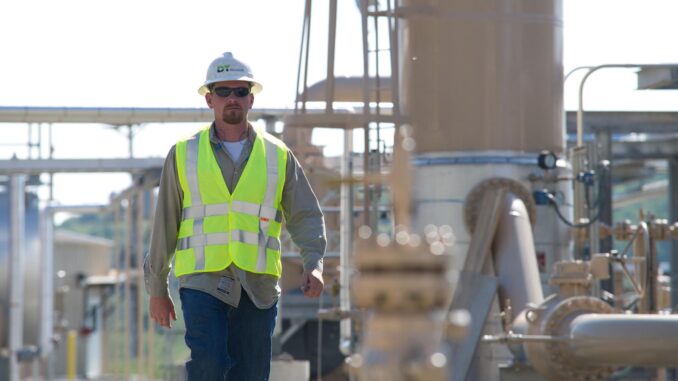
DT Midstream Inc. (NYSE:DTM), a leading player in the natural gas midstream sector, recently released its third-quarter 2025 earnings, showcasing robust financial performance amid a resilient market environment. The Detroit-based company, which operates extensive pipeline and gathering assets primarily in the Haynesville and Appalachia regions, reported results that exceeded analyst expectations and prompted an upward revision to its full-year guidance. This article breaks down the key earnings highlights, provides context on the broader midstream market, compares DTM to its competitors, explores forward-looking statements, and outlines critical factors for investors to monitor.
Key Earnings Information
In its Q3 2025 earnings report, DT Midstream posted net income attributable to the company of $115 million, or $1.13 per diluted share, marking a 7% increase from the $107 million ($1.04 per share) reported in Q2 2025.
This performance surpassed Wall Street consensus estimates, which had pegged EPS at around $1.05.
Adjusted EBITDA for the quarter reached $288 million, up 4% sequentially from $277 million in Q2, driven by strong contributions from both its pipeline and gathering segments.
Breaking it down by segment:
Pipeline Segment: Adjusted EBITDA was $195 million, representing 68% of the total, with a slight 1% increase from Q2. This was bolstered by higher revenues from the Blue Union system due to elevated gathering volumes.
Gathering Segment: Adjusted EBITDA climbed to $93 million, a 12% rise from $83 million in Q2, fueled by record throughput in the Haynesville system at 2.04 Bcf/d—a 35% year-over-year jump.
For the nine months ended September 30, 2025, net income stood at $330 million ($3.22 per share), a 17% improvement over the $281 million ($2.87 per share) from the same period in 2024.
Adjusted EBITDA for the period was $845 million, up 15% year-over-year.
Distributable cash flow for Q3 was $262 million, contributing to a year-to-date total of $669 million.
The company also declared a quarterly dividend of $0.82 per share, payable on January 15, 2026, reflecting confidence in its cash generation capabilities.
Operationally, DTM achieved milestones like placing the LEAP Phase 4 expansion in service early and on budget, adding 0.2 Bcf/d of capacity to its Louisiana Energy Access Project (LEAP).
The Midstream Market Landscape in 2025The midstream oil and gas sector, which encompasses transportation, storage, and processing of hydrocarbons, is experiencing a neutral to modestly positive outlook in 2025, driven by steady North American production growth and surging export demand.
Global energy demand continues to fuel the segment, with U.S. natural gas exports—particularly liquefied natural gas (LNG)—projected to rise by 25% this year.
Asset utilization remains high, supported by modest increases in oil and gas production across North America.
Key trends include structural growth from LNG expansions and industrial demand, with natural gas poised as a resilient fuel amid energy transitions.
The overall market is valued at approximately $32.5 billion in 2025, expected to grow at a 6.1% CAGR to $49.36 billion by 2032.
However, challenges persist, such as fluctuating commodity prices—with Brent crude forecasted to average $62 per barrel in Q4 2025—and regulatory hurdles in carbon management.
Growth is increasingly tied to U.S. hydrocarbon exports, with new pipelines and infrastructure expansions addressing bottlenecks.
How DT Midstream Ranks Among Competitors
DT Midstream operates in a competitive landscape dominated by larger integrated players, but it distinguishes itself through focused assets in high-growth basins like Haynesville and Appalachia. As of November 2025, DTM’s market capitalization stands at approximately $11.2 billion, positioning it as a mid-tier player in the U.S. midstream sector.
pitchbook.com
In comparison:
|
Company
|
Market Cap (Approx., Nov 2025)
|
TTM Revenue (Approx.)
|
Key Notes
|
|---|---|---|---|
|
Enterprise Products Partners (EPD)
|
$65B
|
$52B
|
Largest by market cap; extensive diversified assets.
disfold.com
|
|
Energy Transfer (ET)
|
$60B
|
$80B
|
High revenue from broad operations; focuses on acquisitions.
finance.yahoo.com
|
|
Williams Companies (WMB)
|
$55B
|
$11B
|
Strong in transmission; similar to DTM in natural gas focus.
disfold.com
|
|
Kinder Morgan (KMI)
|
$50B
|
$15B
|
Vast pipeline network; emphasis on storage and terminals.
finance.yahoo.com
|
|
ONEOK (OKE)
|
$45B
|
$18B
|
Growing through midstream integrations.
fool.com
|
|
MPLX (MPLX)
|
$40B
|
$11B
|
Refining-linked assets; stable distributions.
fool.com
|
|
DT Midstream (DTM)
|
$11.2B
|
$1.1B
|
Smaller scale but high growth; 8% EBITDA CAGR (2021-2025) vs. 3% peer average.
s28.q4cdn.com
|
TM ranks outside the top 10 by market cap and revenue but outperforms peers in growth metrics, with an 18% dividend CAGR from 2021-2025 compared to a 7% peer average.
Its $2.3 billion project backlog represents 236% of 2024 EBITDA, far exceeding the 106% peer average, highlighting its expansion potential.
Competitors like ET and EPD benefit from scale, but DTM’s niche in natural gas gathering and transmission offers higher utilization rates tied to LNG demand.
Future Statements and Outlook
DT Midstream’s management expressed optimism, with President and CEO David Slater noting continued strong performance and progress on commercial and construction fronts.
The company raised its 2025 adjusted EBITDA guidance to $1,115-$1,145 million, an 18% midpoint increase from the original outlook, reflecting year-to-date results ahead of plan.
For 2026, early guidance reaffirms $1,155-$1,225 million in adjusted EBITDA.
Key forward-looking initiatives include:Final investment decision on the upsized Guardian Pipeline “G3” expansion, adding 537 MMcf/d capacity by Q4 2028 at a $850-$930 million investment.
Ongoing Appalachia Gathering System Phase 3, set for full in-service in 1H 2026.
Long-term commitment to net-zero greenhouse gas emissions by 2050, with a 30% reduction target in carbon emissions.
Analysts project 12% annual revenue growth over the next three years, driven by high pipeline utilization and LNG-linked demand.
The company anticipates 5-7% long-term adjusted EBITDA growth, supported by demand-based contracts (95% of portfolio) with a seven-year average tenor.
Risks include commodity price volatility, regulatory changes, and geopolitical factors, as outlined in forward-looking statements.
What Investors Should Look For
For investors eyeing DT Midstream, several factors warrant close attention:
Project Execution and Backlog Realization: Monitor progress on the $2.3 billion organic backlog, as timely in-service dates for expansions like Guardian G3 could drive earnings growth.
Throughput Volumes and Utilization: Haynesville and Northeast volumes are key; sustained records could signal stronger cash flows amid rising natural gas demand.
Dividend Sustainability and Growth: With a 12% increase in 2025 dividends, watch distributable cash flow coverage (currently robust) and payout ratios for continued hikes.
Balance Sheet Health: DTM maintains investment-grade ratings and 3.1x on-balance sheet leverage; any shifts due to capital expenditures ($445-$485 million in 2025) could impact flexibility.
Market Demand Drivers: Track U.S. LNG exports and natural gas prices, as DTM’s assets are well-positioned for Gulf Coast and Chicago market access.
Sustainability Initiatives: Advances in carbon capture projects, like the Louisiana sequestration effort, could enhance ESG appeal and open new revenue streams.
Overall, DTM’s focused strategy in growing basins positions it well for midstream tailwinds, but investors should weigh execution risks against the sector’s stable, fee-based revenue model.
Conclusion
DT Midstream’s Q3 2025 results underscore its operational strength and strategic positioning in a midstream market buoyed by export-driven growth. While smaller than giants like EPD or ET, DTM’s superior growth trajectory and project pipeline make it an intriguing option for income-focused investors. As the energy landscape evolves, DTM’s commitment to expansion and sustainability could yield long-term value.









